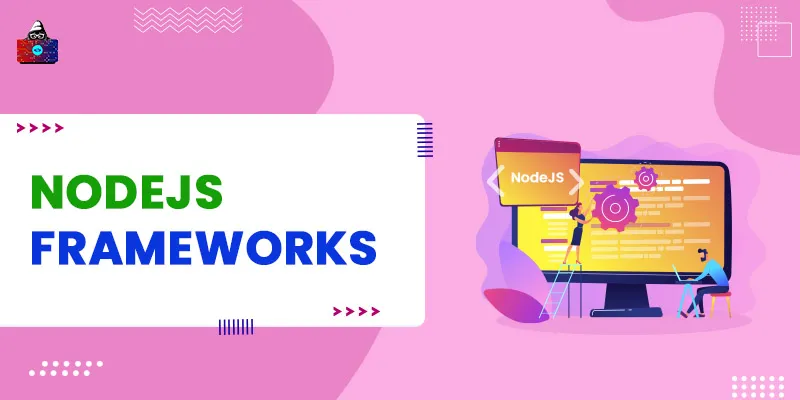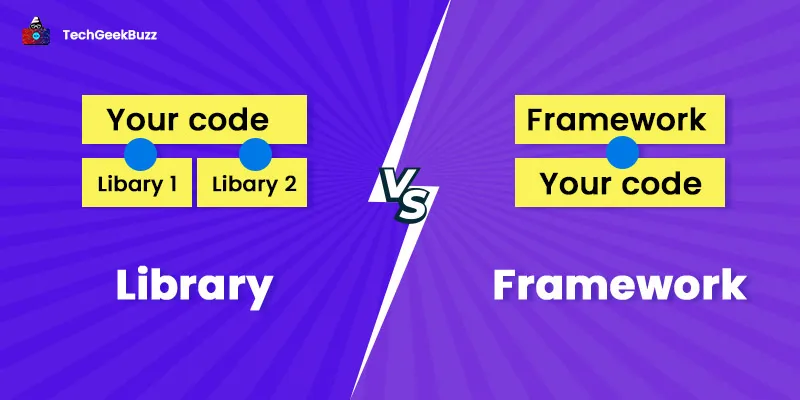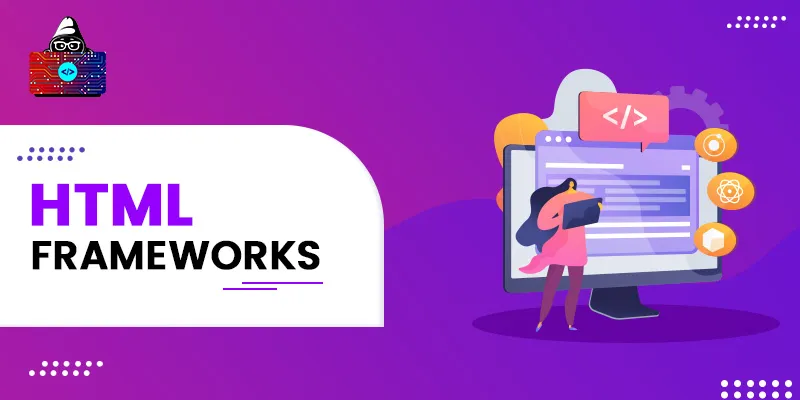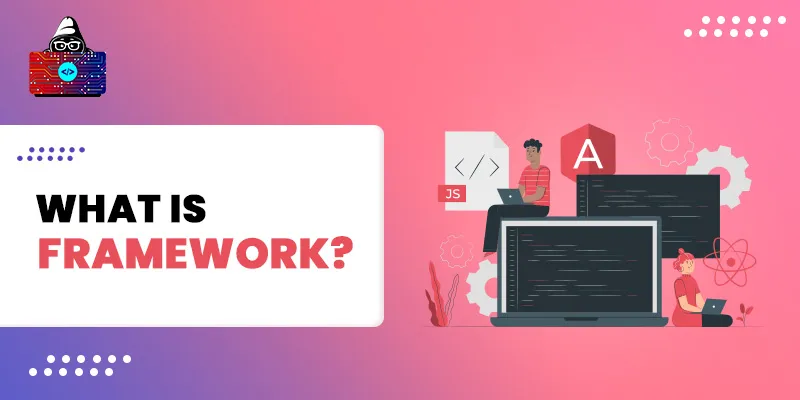- What is Node.js?
- Features
- Is Node.js a Framework?
- What is a Node.js Framework?
- Top 10 Node.js Frameworks To Use in 2023
- 1. Express.js
- Features
- 2. Nest.js
- Features
- 3. Meteor
- Features
- 4. Koa.js
- Features
- 5. Sails.js
- Features
- 6. Hapi.js
- Important Features of Hapi
- 7. LoopBack
- Features
- 8. Socket.io
- 9. DerbyJS
- Features
- 10. Total.js
- Features
- Which NodeJS Web Framework to Learn in 2023?
- Conclusion
With the rapid technological advancements, developers managed to use JavaScript for backend development with Node.js. Check out the list of popular Node.js frameworks here.
Over the past few years, JavaScript has emerged as one of the most popular programming languages . It is the most popular client-side scripting language for creating dynamic websites and web applications.
According to W3Techs, JavaScript powers 98% of the total websites on the web.
Along with client-side development, JavaScript has also become popular for server-side development with the help of Node.js. It is a runtime environment to execute JavaScript code outside a browser.
The inception of Node.js has made it possible for web developers to accomplish both front-end and back-end development with just a single language – JavaScript. This means you can become a full-stack developer just by learning JS.
As Node.js has an active community of developers, they constantly strive to develop new frameworks. Hence, it becomes overwhelming to pick the best one. When 4 out of 5 back-end and full-stack developers use JS as their back-end language, they opt for Node.js frameworks to facilitate the development process.
In this blog post, I shall walk you through some of the best Node.js frameworks that are popular and widely used among web developers .
What is Node.js?
Node.js is an open-source, platform-independent JavaScript runtime environment capable of executing JavaScript code on the server side (and outside a web browser). It makes it possible for developers to use JS for server-side scripting and writing command-line tools .
Features
- Asynchronous and Event-Driven: All the APIs of a Node.js library are asynchronous or non-blocking. The server does not have to wait for an API to return the data. From any previous API requests it wants to track a response, it leverages the event mechanism.
- Highly Scalable: Though the environment is single-threaded, it is highly scalable. A single-threaded program is capable of handling a large number of requests. This is because the event mechanism enables the server to respond in a non-blocking way.
- No Buffering: There is no buffering of Node.js applications.
- Quick Code Execution: The runtime environment runs on Google Chrome’s V8 engine , making it possible to execute the code faster.
Is Node.js a Framework?
It is a longtime debate among developers about whether Node.js is a framework. Technically, it is a runtime environment for JS that executes code outside the browser.
A runtime environment is a platform to run programs, while a framework serves as the foundation or skeletal structure for developing applications.
What is a Node.js Framework?
We use a web framework to reduce the time and effort required to create a web application. It is a collection of modules, pre-written code, libraries, and other components used to build web applications faster. It eliminates the need to create applications from scratch.
There are three different types of Node.js frameworks, as follows:
-
MVC
It provides a design pattern that splits an application into three sections - model, view, and controller . This design pattern separates an application’s presentation and the code business logic. It makes it easy to develop applications. Also, these applications are easy to maintain and scale.
-
REST (REpresentational State Transfer) API
It enables developers to easily create network applications without worrying about their architectural styles. Further, it provides a ready-to-code interface that helps developers save money, effort, and time.
-
Full-Stack
It comes with everything you need to develop a fully-functional application. It handles both the client-side as well as server-side development of applications.
Top 10 Node.js Frameworks To Use in 2023
The following are our best picks, and many companies choose among them, as they help reduce resource consumption and delivery time.
1. Express.js
- GitHub stars: 59.4K
- Type: MVC (Sinatra-like)
- Latest Release: 4.18.1

The minimalistic approach of Express.js or Express makes it the best of all. It is an unopinionated framework for creating single-page, multi-page, and hybrid applications. In addition, it helps develop mobile applications and APIs.
Developed by TJ Holowaychuk in 2010, Express.js has become a de facto standard for Node.js. In addition, it is one of the components of several back-end technology stacks – MEAN, MERN, and MEVN.
Being an unopinionated framework, it does not care about what technologies you use. Also, it is lightning-fast and straightforward, and easy to set up. Though Express.js is minimal, it provides all functionalities via plugins.
It provides:
- All the HTTP utility methods
- Functions
- Middleware that helps developers to write robust APIs
The foremost benefit of using Express.js is that it offers continuous updates and constant improvements.
Features
- Express.js has many Node.js features that accelerate writing source code and save time.
- Provides exceptionally high test coverage, enabling developers to create applications with maximum testability.
- Provides URLs to HTTP heads that help better client and server communication.
- Supports the setup of middleware that helps with responding to HTTP headers.
- A routing table makes it possible to perform actions based on the HTTP method and URL.
- Supports dynamic rendering of HTML pages by passing arguments to templates.
When to Use?
You can use Express.js to create web or mobile applications and APIs quickly. A few robust features, including routing, templating, and error handling, make it an ideal solution for creating browser-based and enterprise-grade applications.
2. Nest.js
- GitHub stars: 53.2K
- Type: REST API
- Latest Release: 9.2.1

Nest.js is a progressive Node.js framework for developing scalable, efficient, and easy-to-maintain server-side applications. It uses TypeScript as its primary programming language and not JavaScript.
Its native language, TypeScript, provides powerful elements such as object-oriented programming, functional programming , and functional reactive programming (FRP). As a result, this helps in doubling developers' productivity while saving development time.
Also, Nest.js provides a command-line interface (CLI) that helps developers integrate other front-end tools. It has a set of libraries, making it a perfect choice for creating multi-layered enterprise-grade applications.
As it is developed in TypeScript, it has a clean-code architecture and maintains the complexity of large-scale applications. It seamlessly integrates with Fastify and Express.js, which are sister frameworks.
Features
- Functional reactive programming (FRP) simplifies the development of complex applications.
- Designed for monolithic and microservices.
- Comes with a modular architecture that allows developers to use any library.
- Uses a strongly typed language called TypeScript.
- Low learning curve.
- Unit testing of applications is easy.
When to Use?
Use Nest.js for creating scalable, complex, enterprise-grade, and easy-to-maintain web applications.
3. Meteor
- GitHub stars: 43.2K
- Type: Full-stack
- Latest Release: 2.1

If you are a champion in JavaScript, Meteor is an ideal solution for your back-end development. It is a full-stack, cross-platform framework for creating web and mobile applications. Meteor makes it easy to create and deploy web, mobile, and desktop applications with JS and TypeScript.
The most admirable feature of Meteor is that it seamlessly integrates with other popular technologies, such as front-end frameworks – Vue, React, Svelte, Angular, or Blaze, and database systems – MongoDB.
More interestingly, you do not have to write code separately for creating applications for different platforms, like Android, iOS, and desktop. A single codebase covers all platforms.
Furthermore, Meteor.js propagates data changes to clients without requiring developers to write code. This is because of its Distributed Data Protocol and a publish-subscribe pattern.
Being a full-stack framework, developers can stick to a single language – JavaScript. It works in conjunction with React and Vue.js for front-end development. Also, it monitors the data flow between the cloud and the client applications and even the client UI state and rendering.
Features
- Open-source with an active community of developers. Built-in features like hot code reload, automatic CSS and JS minification, and reactive templates.
- Works with front-end frameworks like Vue, React, Svelte, Angular, or Blaze.
- With the help of Cordova and Meteor, developers can convert a web application into a smartphone app.
- Comes with a cloud platform called Galaxy to deploy and manage client applications.
When to Use?
If you specialize in JavaScript, Meteor.js is a perfect pick for you. It is an ideal solution for developing real-time applications for Android, iOS, or desktop.
4. Koa.js
- GitHub stars: 33.5K
- Type: MVC (Sinatra-like)
- Latest Release: 2.14.1

Koa could be considered the extension of Express.js because it is an MVC-based framework designed and developed by the Express team. This next-generation tool enables the seamless development of web and mobile applications.
The primary purpose of developing Koa.js was to offer a framework that was more lightweight than Express and capable of developing web applications and APIs more efficiently.
Creating APIs is fun with Koa.js, as it leverages a stack-like approach to dealing with HTTP middleware. In addition, it makes it possible to maintain different representations of content to users with the same URL.
Though it contains fewer libraries and components than Express, Koa.js has many new features. In comparison with Express.js, the error-handling capability of Koa.js is far better.
Further, Koa.js makes it easy and enjoyable to write HTTP middleware and enhances interoperability and robustness. As Koa.js provides more freedom and reduces complexities while writing code, it minimizes the possibility of errors throughout the development process.
Features
- A lightweight and more flexible version of Express.js.
- Comes with inbuilt tasks, such as cache freshness, content negotiation, and proxy support. Leverages the Asynchronous function, which helps to ditch the callbacks.
- Better error handling capabilities.
- Maintains the source code to be clean while normalizing the Node.js inconsistencies.
- Has the syn/await keyword that manages the code for you and keeps it clean.
When to Use?
If your requirement is developing a performance-critical application that is large and complex, Koa.js is a go-to solution. Also, it is faster and more flexible than Express.js. But remember, beginners may find Koa.js pretty tricky to use and learn.
5. Sails.js
- GitHub stars: 22.4K
- Type: MVC (Rails-like architecture)
- Latest Release: 1.5.3

Developed on top of Node.js, Sails.js is open-source and used for creating web applications, APIs, and real-time apps. It supports modernized and data-oriented development. Sails.js works seamlessly with other JS frameworks and is compatible with all major databases.
If we consider features as the primary standard to compare Sails.js and ExpressJS, then the former has more potential. It is similar to Express.js, yet many developers and Sails itself boast that it is better than Express. This is because it offers many features that Express still needs to have.
Sails.js makes the development of high-end customized applications easy. Also, it reduces the amount of code you need to write to integrate your application with npm modules. It performs HTTP requests using Express.js, and for Websockets, it depends on Socket.io , a JS library for bidirectional and event-based communication.
Moreover, it is lightweight and faster than Express. It provides an ORM (Object Relational Mapping) interface, which allows it to integrate with any database system, such as MySQL, MongoDB, PostgreSQL, Redis, and local disk.
Features
- Seamlessly integrates with Socket.io and Express.js.
- Hosts a set of features and attributes.
- Provides an ORM interface.
- Auto-generate REST APIs.
- Reusable and declarative security policies.
- Flexible asset pipeline.
- Purely developed in JS.
When to Use?
Sails.js is a perfect solution for creating real-time, customized chat, gaming, and social media applications.
6. Hapi.js
- GitHub stars: 14.1K
- Type: MVC (Sinatra-like)
- Latest Release: 21.1.0

Developed by Eran Hammer in 2011 at Walmart, Hapi helps you build robust and scalable APIs, server-side applications, and proxy servers with minimal overhead.
Hapi.js helps transfer data between server and client with the help of APIs and is also known as the server framework. It is similar to Express.js but with fewer features, but you can extend it through a broad set of plugins.
A few popular features of Hapi.js include input validation, implement caching,configuration-based functionality, error handling, logging, and more. Some developers even suggest Hapi as the perfect substitute for Express, yet it has a small community.
Important Features of Hapi
- Provides proper control for requesting handling.
- Allows you to write robust APIs.
- Does not use middleware.
- Code reusability.
- Built-in features like caching, authentication, and input validation.
- Seamless integration with other tools.
- Supports various types of databases.
- Comes with a JavaScript Templating Engine, which makes rendering dynamic web pages easy.
When to Use?
Hapi.js is a perfect solution for creating scalable, secure, real-time social media applications, HTTP proxy servers, and APIs.
7. LoopBack
- GitHub stars: 13.3K
- Type: REST API
- Latest Release: 3.28.0

LoopBack is open-source and used to create powerful and dynamic REST APIs within less time. It comes with an easy-to-use command-line interface (CLI) that helps to integrate it with other front-end technologies. Also, it features a dynamic API explorer.
With LoopBack, it is possible to create dynamic models and schema models. It connects with any Node.js framework and integrates with different API services. Also, it offers the flexibility to connect with different devices and browsers.
Along with writing REST APIs, LoopBack also supports integration with different databases, such as relational and NoSQL database management systems that include MySQL, Oracle, MongoDB, and PostgreSQL .
Further, the framework helps you upkeep the different application modules, significantly reducing the development time.
Features
- The quick development of networked applications.
- Built-in client API explorer.
- Highly extensible.
- Clean and module codes.
- Comprehensive documentation.
When to Use?
LoopBack is an excellent pick for creating powerful APIs and handling API requests.
8. Socket.io
- GitHub stars: 57.4K
- Type: Full-stack
- Latest Release: 4.5.4

Though Socket.io is a JS library, it functions similarly to a framework. It is a perfect tool for creating real-time web applications facilitating bidirectional communication between the client and server. It comes with a client-side and server-side library.
This library makes easy the development of applications that requires WebSocket. With fewer lines of code, you get real-time analytics for your application. Also, the library comes with an API that can easily integrate with any service.
Features
- Multiplexing and binary support.
- Auto-reconnection support.
- Error detection and auto-correction.
When to Use?
The development of real-time applications, like a chat room, video conferencing, multiplayer games, etc., are possible with the help of Socket.io.
9. DerbyJS
- GitHub stars: 4.7K
- Type: Full-stack
- Latest Release: 2.0.1

DerbyJS is ideal for building modern web and mobile real-time applications. It leverages the MVC design pattern, which makes it easy for developers to write the source code. In addition, it supports npm to add extra features to the DerbyJS project.
The framework is ideal for real-time web applications because it allows the same code to run on the server and the client.
Although DerbyJS has a small community, it has enormous potential to become a prominent Node.js framework. It offers a variety of features, including data synchronization, real-time concurrency, API development, and the capability to develop dynamic web pages.
Features
- Integrates with Derby Racer, a data synchronization engine that synchronizes data between the browser and the server.
- Support for offline usage.
- Developers can write multi-user applications.
- Supports client-side view rendering on the server.
- Code-sharing across client-side and server-side.
When to Use?
If you want to create fast-loading real-time applications, DerbyJS is the best pick for you. DerbyJS makes content loading faster and offers real-time data synchronization.
10. Total.js
- GitHub stars: 4.2K
- Type: MVC
- Latest Release: 4

Total.js facilitates the development of web applications and REST APIs. Released in 2013, the main goal of designing Total.js is to create a complex, stable framework that works without dependencies. It contains many libraries, packages, and other components written in Total.js.
Being open-source, Total-.js provides complete freedom to developers and is fully-fledged, offering a CMS-like experience. Eshop, CMS, and HelpDesk are three different versions of Total.js. With these variations, your application can integrate with IoT applications, REST services, and other super-fast applications.
It seamlessly integrates with client-side frameworks, including Angular, Bootstrap, Backbone.js, and Polymer.
Features
- Integration support with powerful NoSQL databases.
- Provides WebSockets for real-time applications.
- Comes with many UI components.
- Supports the SMTP mail sender protocol.
- Real-time tracking.
- API testing.
When to Use?
Use Total.js when you need to develop real-time and super-fast applications. It is the best for developing interfaces in IoT, cloud services, real-time collaboration apps, and eCommerce applications.
Which NodeJS Web Framework to Learn in 2023?
The framework market is unstable, and thus, no one can predict the future of these Node.js frameworks. Unlike programming languages, we replace old frameworks with new ones. So keep this in mind when you learn a framework; therefore, be always ready to switch from one to another.
All frameworks mentioned above are the best for now. Please do not choose solely based on its GitHub stars. Instead, pick one with great potential, check all the boxes for your project, is easy to learn, and can be integrated with other trending technologies, such as MongoDB and Angular.
Conclusion
Node.js, a runtime environment, can help you develop server-side applications using JavaScript. Each Node.js framework listed above has features that make it different from others. So, you can choose one that meets your project requirements to get started with back-end development.
We hope this article helped you find a suitable Node.js framework for your project. If you have any suggestions related to this article, please share them in the comments section below.
People are also reading:
- Web Development Frameworks
- Python Frameworks
- PHP Frameworks
- Java Frameworks
- Best Front End Developer Interview Questions
- HTML Interview Questions
- Difference between Nodejs and PHP
- Best JavaScript IDEs
- What is Node.js Used For?
- Best JavaScript Libraries





Leave a Comment on this Post